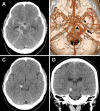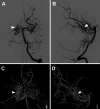Coexistence of anterior choroidal artery and posterior cerebral artery retia mirabilia presenting with subarachnoid hemorrhage: illustrative case
- PMID: 38163352
- PMCID: PMC10763634
- DOI: 10.3171/CASE23580
Coexistence of anterior choroidal artery and posterior cerebral artery retia mirabilia presenting with subarachnoid hemorrhage: illustrative case
Abstract
Background: A rete mirabile is a rare vascular anomaly, with posterior cerebral artery (PCA) involvement being especially rare. Its pathogenesis has been speculated as a remnant of "distal annexation" between the primitive anterior choroidal artery (AchA) and the PCA at this site, but the exact mechanisms remain unclear.
Observations: A 29-year-old man presented with subarachnoid hemorrhage. Arteriovenous malformation in the medial temporal lobe was initially suspected, but an arteriovenous shunt was not detected. First, conservative treatment was administered; however, rebleeding occurred 1 month later. Carotid angiography revealed a network-like cluster of blood vessels at the choroidal point of the AchA, suggesting a rete mirabile; these vessel clusters led to the persistent temporo-occipital branch of the AchA. Furthermore, an aneurysm was detected at the junction between the rete mirabile and the persistent temporo-occipital branch of the AchA. Additionally, vertebral angiography demonstrated a rete mirabile at the P2 segment. These findings suggested the coexistence of AchA and PCA retia mirabilia. Consequently, the aneurysm was clipped using a subtemporal approach to prevent re-rupture, and the postoperative course was uneventful.
Lessons: This first report of coexisting AchA and PCA retia mirabilia supports the remnant of distal annexation between the primitive AchA and the PCA as the reason for rete formation at this site.
Keywords: pure arterial malformation; anterior choroidal artery; arteriovenous malformation; cerebral aneurysm; posterior cerebral artery; rete mirabile.
Conflict of interest statement
Figures




Similar articles
-
Unilateral rete mirabile in multiple intracranial arteries with ipsilateral agenesis of the internal carotid artery: a case report.J Med Case Rep. 2023 Jun 29;17(1):268. doi: 10.1186/s13256-023-04013-w. J Med Case Rep. 2023. PMID: 37381055 Free PMC article.
-
A rete mirabile of the posterior cerebral artery. Embryonic and phylogenetic remnant of choroidal artery origin.Interv Neuroradiol. 2008 Jun 30;14(2):195-202. doi: 10.1177/159101990801400212. Epub 2008 Jun 30. Interv Neuroradiol. 2008. PMID: 20557762 Free PMC article.
-
Accessory posterior cerebral artery as a duplicate anterior choroidal artery.Surg Radiol Anat. 2025 Jan 22;47(1):61. doi: 10.1007/s00276-024-03561-0. Surg Radiol Anat. 2025. PMID: 39841257
-
[A case of rete mirabile with congenital dysplasia of bilateral internal carotid arteries].No Shinkei Geka. 2000 Feb;28(2):161-6. No Shinkei Geka. 2000. PMID: 10666736 Review. Japanese.
-
Rete mirabile associated with pial arteriovenous fistula: imaging features with literature review.BMJ Case Rep. 2017 Feb 16;2017:bcr2016012939. doi: 10.1136/bcr-2016-012939. BMJ Case Rep. 2017. PMID: 28209646 Free PMC article. Review.
References
LinkOut - more resources
Full Text Sources

